Design and Simulation of Cross-Medium Two-Hop Relaying Free-Space Optical Communication System Based on Multiple Diversity and Multiplexing Technologies
Abstract
1. Introduction
2. Design and Parameters of the Proposed System
3. Channel Model
3.1. Oceanic and Atmospheric Turbulence Model
3.2. Weather Model
3.3. Chlorophyll Model
4. Results and Discussion
4.1. Simulation and Analysis of the Atmospheric Subsystem
4.2. Simulation and Analysis of the Hybrid Two-Hop Relay System
5. Conclusions
Author Contributions
Funding
Institutional Review Board Statement
Informed Consent Statement
Data Availability Statement
Conflicts of Interest
References
- Wu, Y.; Kong, D.; Wang, Q.; Li, G. Performance analysis of UAV-assisted hybrid FSO/RF communication systems under various weather conditions. Sensors 2023, 23, 7638. [Google Scholar] [CrossRef]
- Kaushal, H.; Kaddoum, G. Underwater optical wireless communication. IEEE Access 2016, 4, 1518–1547. [Google Scholar] [CrossRef]
- Tahir, F.A.; Das, B.; Abdullah, M.F.L.; Gismalla, M.S.M. Design and analysis of variation in chlorophyll and depth for open ocean underwater optical communication. Wirel. Pers. Commun. 2021, 116, 1273–1291. [Google Scholar] [CrossRef]
- Wang, T.; Yu, X.; Zhao, B.; Pang, D. Error characterization of differential detection and non-differential detection for MIMO UWOC systems in seawater turbulent channels. Photonics 2023, 10, 859. [Google Scholar] [CrossRef]
- Huang, Y.; Zheng, X.; Guo, Y.; Gao, S. Performance Improvement of the Free-Space Optical Communication Link Using Spatial Diversity Reception-Assisted OFDM Signals. Appl. Sci. 2022, 12, 6828. [Google Scholar] [CrossRef]
- Fang, X.; Zhang, F. Phase noise estimation and suppression for PDM CO-OFDM/OQAM systems. J. Light. Technol. 2017, 35, 1837–1846. [Google Scholar] [CrossRef]
- Ghalot, R.; Madhu, C.; Kaur, G.; Singh, P. Link estimation of different Indian cities under fog weather conditions. Wirel. Pers. Commun. 2019, 105, 1215–1234. [Google Scholar] [CrossRef]
- Hasan, M.N.; Wadday, A.G.; Ali, F.M.; Azzawi, H.M. Performance Evaluating of DD-OFDM Based on MIMO System for Underwater Optical Wireless Communications. Test Eng. Manag. 2020, 83, 25589–25598. [Google Scholar]
- John, M.A.J.; Gokul, P. Performance evaluation and simulation of OFDM in optical communication systems. Int. J. Eng. Res. Appl. 2015, 5, 1–4. [Google Scholar]
- Kaur, G.; Srivastava, D.; Singh, P.; Parasher, Y. Development of a novel hybrid PDM/OFDM technique for FSO system and its performance analysis. Opt. Laser Technol. 2019, 109, 256–262. [Google Scholar] [CrossRef]
- Chaudhary, S.; Sharma, A.; Khichar, S.; Shah, S.; Ullah, R.; Parnianifard, A.; Wuttisittikulkij, L. A salinity-impact analysis of polarization division multiplexing-based underwater optical wireless communication system with high-speed data transmission. J. Sens. Actuat. Netw. 2023, 12, 72. [Google Scholar] [CrossRef]
- Singh, M.; Malhotra, J.; Atieh, A.; El-Khozondar, H.J.; Dhasarathan, v. Performance investigation of 1.6 Tbps hybrid WDM-PDM-OFDM-based free space optics transmission link. Wirel. Pers. Commun. 2021, 117, 2285–2309. [Google Scholar] [CrossRef]
- Sinha, S.; Kumar, C.; Armghan, A.; Singh, M.; Alsharari, M.; Aliqab, K. Capacity enhancement analysis of an OAM-OFDM-SMM multiplexed free space communication system in atmospheric turbulence. Appl. Sci. 2023, 13, 3897. [Google Scholar] [CrossRef]
- Chaudhary, S.; Wuttisittikulkij, L.; Nebhen, J.; Tang, X.; Saadi, M.; Al Otaibi, S.; Althobaiti, A.; Sharma, A.; Choudhary, S. Hybrid MDM-PDM based Ro-FSO system for broadband services by incorporating donut modes under diverse weather conditions. Front. Phys. 2021, 9, 756232. [Google Scholar] [CrossRef]
- Singh, M.; Malhotra, J. Study of spectral-efficient 400 Gbps FSO transmission link derived from hybrid PDM-16-QAM with CO-OFDM. In Proceedings of the International Conference on Paradigms of Computing, Communication and Data Sciences, Singapore, 20 February 2021; pp. 433–441. [Google Scholar]
- El-Mottaleb, S.A.A.; Singh, M.; Aly, M.H. 120 Gbps FSO transmission system based on integrated OFDM-PDM-OCDMA transmission using ICSM code: Performance analysis. Opt. Quantum Electron. 2024, 56, 621. [Google Scholar] [CrossRef]
- San, X.; Liu, Z.; Wang, Y. Research on Mitigating Atmosphere Turbulence Fading by Relay Selections in Free-Space Optical Communication Systems with Multi-Transceivers. Photonics 2024, 11, 847. [Google Scholar] [CrossRef]
- Chen, J.; Yu, Z.; Wang, T.; Liu, Z.; Gao, S. Demonstration of an optical phase conjugation based dual-hop PDM-QPSK free-space optical communication link. Electron. Lett. 2022, 58, 252–254. [Google Scholar] [CrossRef]
- Balaji, K.; Praveen Bagadi, K. Performance analysis of relay assisted multihop coherant OFDM system over Malaga distribution with pointing errors. J. Opt. Commun. 2021, 42, 545–554. [Google Scholar] [CrossRef]
- Levidala, B.K.; Ramavath, P.N.; Krishnan, P. High-speed long-range multihop underwater wireless optical communication convergent with free-space optical system for optical internet of underwater things and underwater optical wireless sensor network applications. Opt. Eng. 2022, 61, 076107. [Google Scholar] [CrossRef]
- Kumar, L.B.; Ramavath, P.N.; Krishnan, P. Performance analysis of multi-hop FSO convergent with UWOC system for security and tracking in navy applications. Opt. Quantum Electron. 2022, 54, 327. [Google Scholar] [CrossRef]
- Mohsan, S.A.H.; Mazinani, A.; Othman, N.Q.H.; Amjad, H. Towards the internet of underwater things: A comprehensive survey. Earth Sci. Inform. 2022, 15, 735–764. [Google Scholar] [CrossRef]
- Lian, D.; Gao, Y.; Lian, J. Cross-Water–Air Optical Wireless Communication Using Orthogonal Time–Frequency Space Modulation. Symmetry 2024, 16, 571. [Google Scholar] [CrossRef]
- Rahman, Z.; Zafaruddin, S.M.; Chaubey, V.K. Direct air-to-underwater optical wireless communication: Statistical characterization and outage performance. IEEE Trans. Veh. Technol. 2022, 72, 2655–2660. [Google Scholar] [CrossRef]
- Yang, L.; Zhu, Q.; Li, S.; Ansari, I.S.; Yu, S. On the performance of mixed FSO-UWOC dual-hop transmission systems. IEEE Wirel. Commun. Lett. 2021, 10, 2041–2045. [Google Scholar] [CrossRef]
- Ali, M.F.; Jayakody, D.N.K.; Garg, S.; Kaddoum, G.; Hossain, M.S. Dual-hop mixed FSO-VLC underwater wireless communication link. IEEE Trans. Netw. Serv. Manag. 2022, 19, 3105–3120. [Google Scholar] [CrossRef]
- Yadav, S.; Aggarwal, M.; Vats, A.; Ahuja, S. Performance analysis of a dual-hop parallel relayed mixed FSO-UWOC system. J. Opt. Commun. 2025, 45, s1503–s1509. [Google Scholar] [CrossRef]
- Levidala, B.K.; Ramavath, P.N.; Krishnan, P. Performance enhancement using multiple input multiple output in dual-hop convergent underwater wireless optical communication–free-space optical communication system under strong turbulence with pointing errors. Opt. Eng. 2021, 60, 106106. [Google Scholar] [CrossRef]
- Fu, Y.; Du, Y. Performance of heterodyne differential phase-shift-keying underwater wireless optical communication systems in gamma-gamma-distributed turbulence. Appl. Opt. 2018, 57, 2057–2063. [Google Scholar] [CrossRef]
- Prokes, A. Atmospheric effects on availability of free space optics systems. Opt. Eng. 2009, 48, 066001. [Google Scholar] [CrossRef]
- Wu, Y.; Mei, H.; Dai, C.; Zhao, F.; Wei, H. Design and analysis of performance of FSO communication system based on partially coherent beams. Opt. Commun. 2020, 472, 126041. [Google Scholar] [CrossRef]
- Prieur, L.; Sathyendranath, S. An optical classification of coastal and oceanic waters based on the specific spectral absorption curves of phytoplankton pigments, dissolved organic matter, and other particulate materials 1. Limnol. Oceanogr. 1981, 26, 671–689. [Google Scholar] [CrossRef]
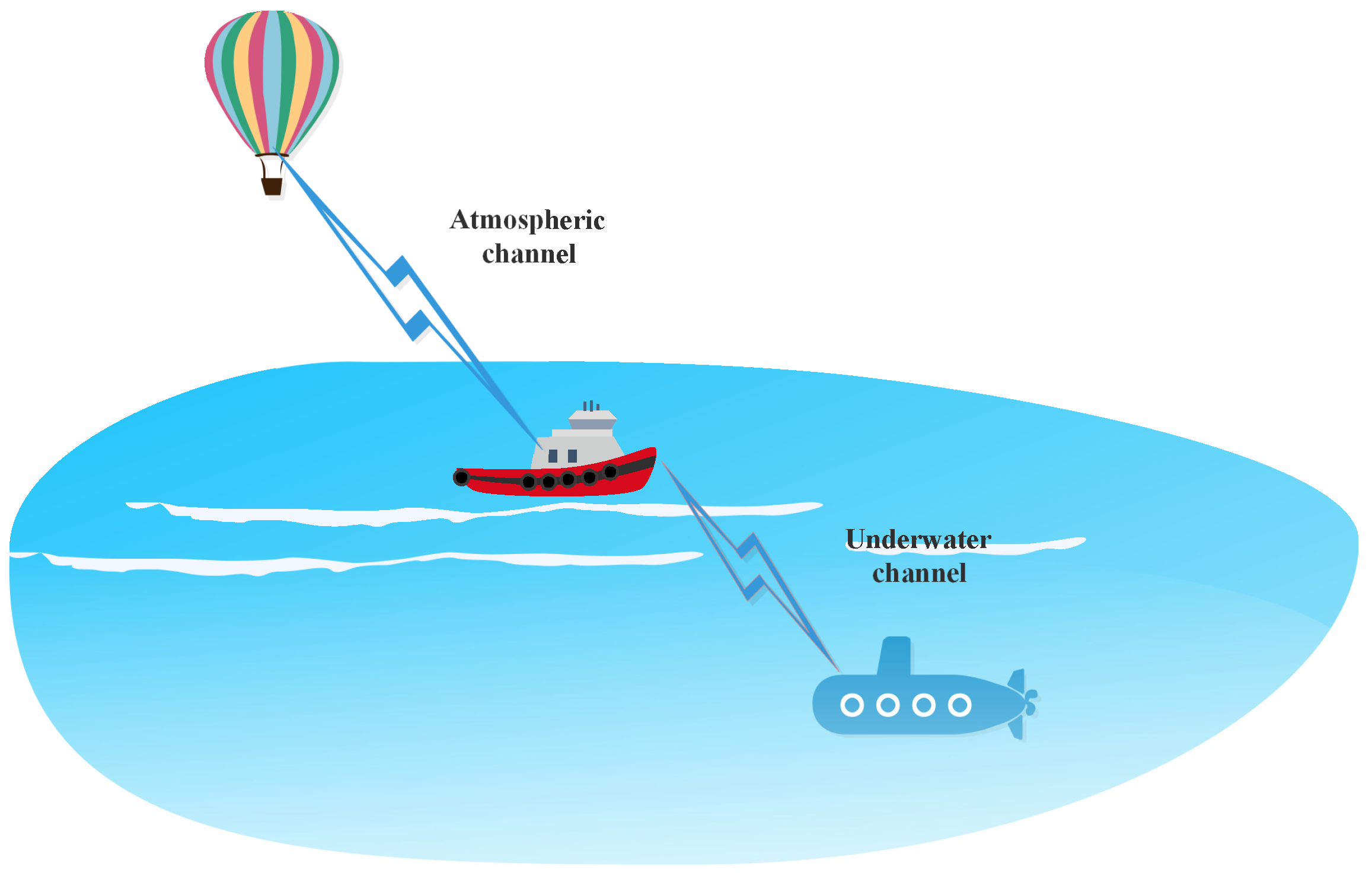
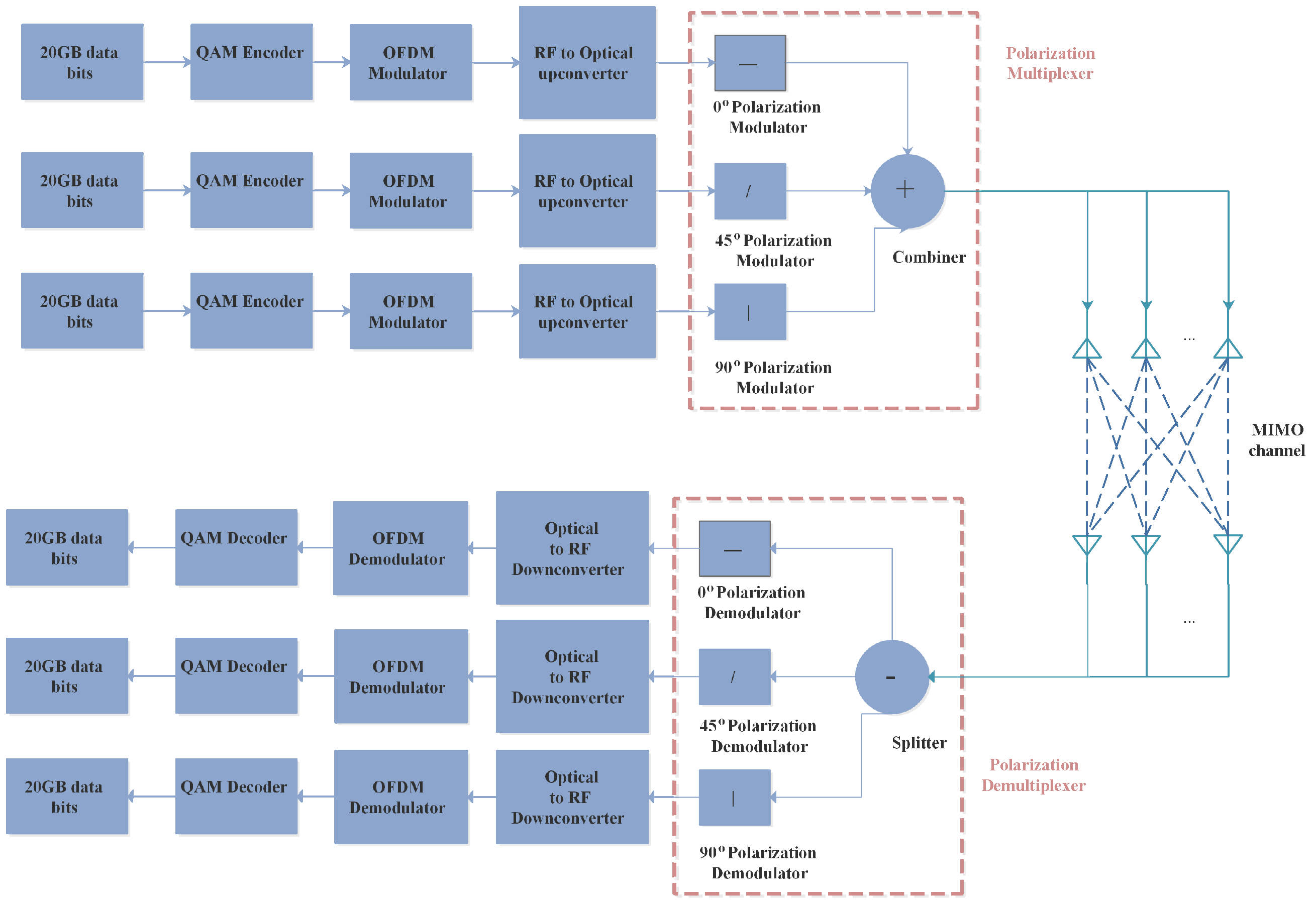
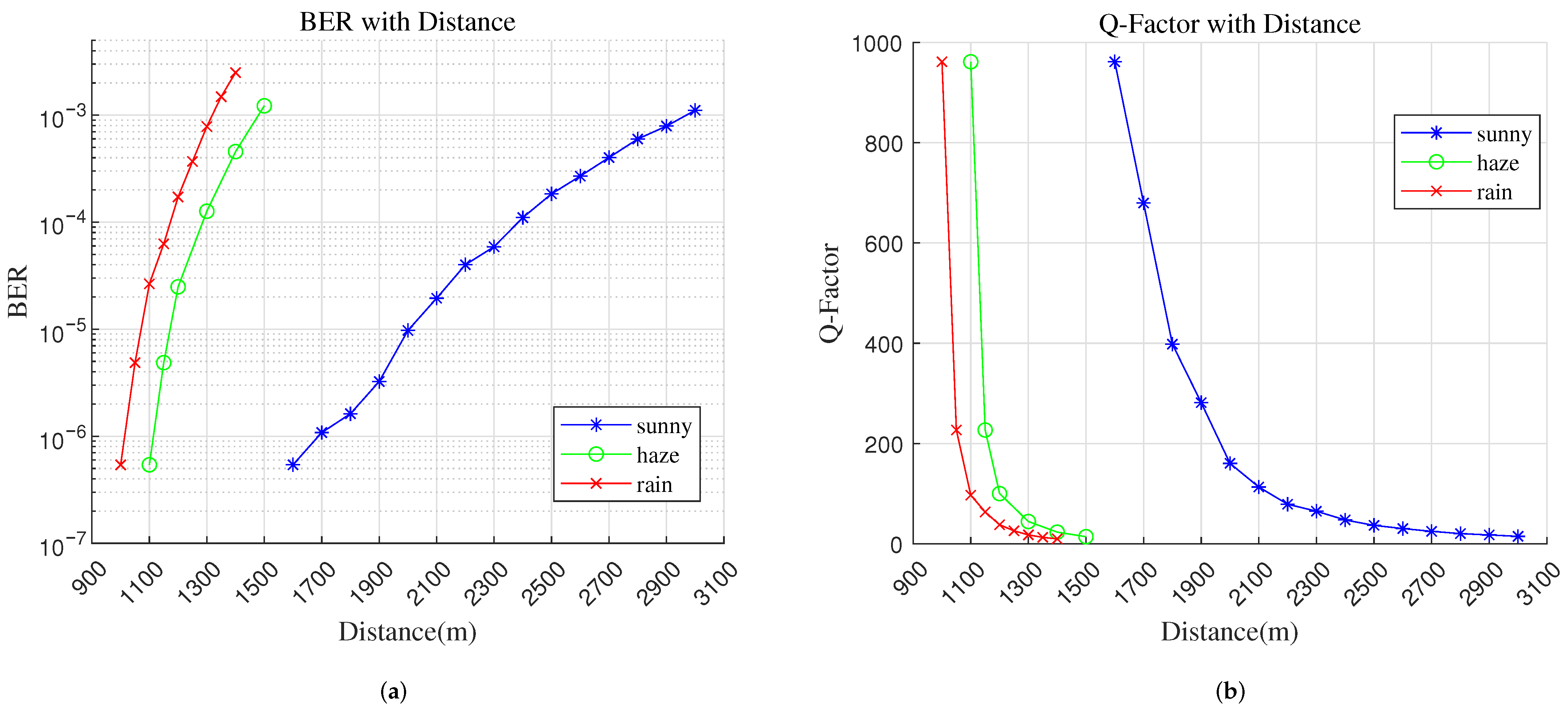
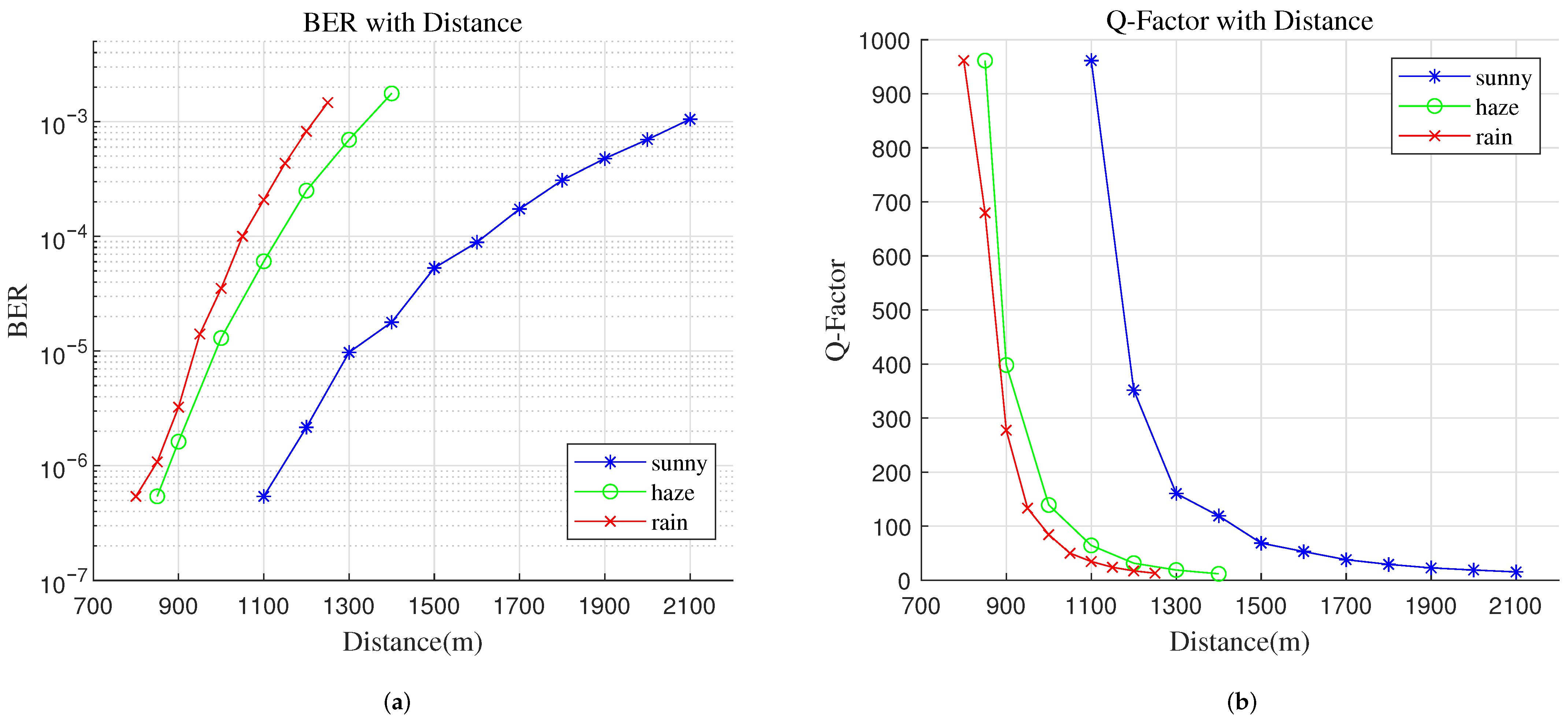
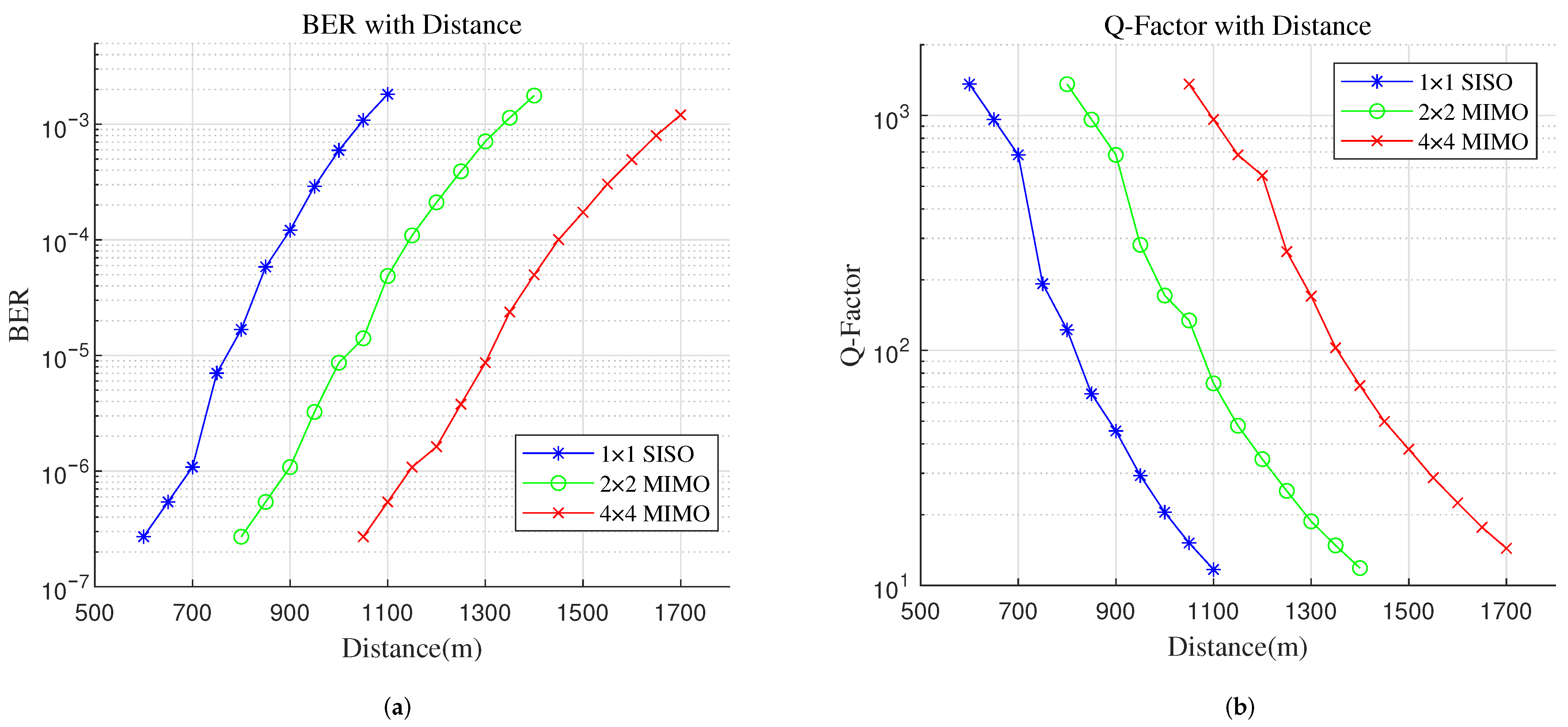

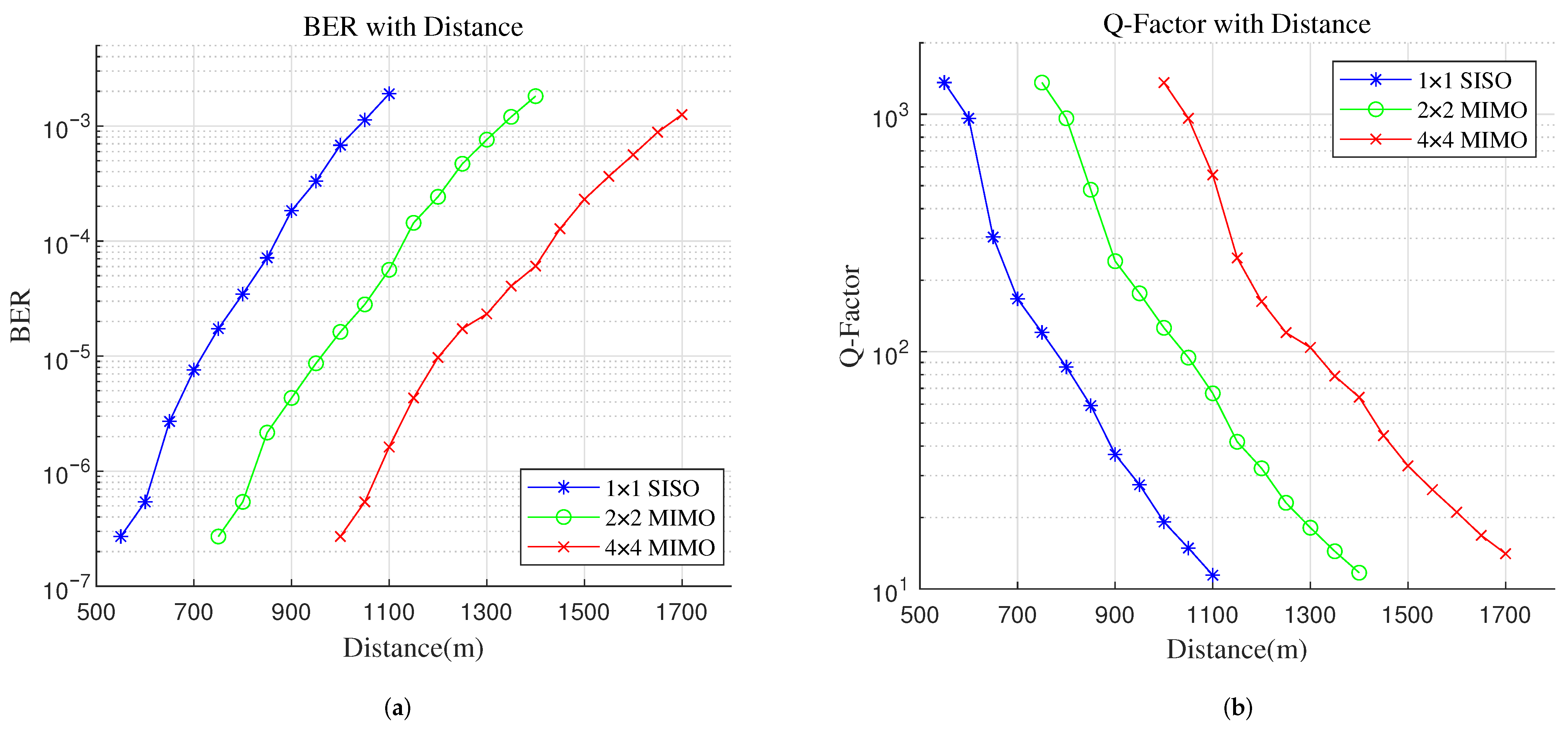






| Ref. | Relay | Atmospheric Link | Oceanic Link | Metrics | ||||
|---|---|---|---|---|---|---|---|---|
| Modulation | Channel | Length | Modulation | Channel | Length | |||
| [23] | × | OTFS | Wind speed | >100 m | OTFS | Clean water | >50 m | BER, Throughput |
| [24] | × | IM/DD | Turbulence, Fog, Pointing Errors | 20 m | - | Turbulence, Air-to-Water interface | 20–80 m | Outage Probability |
| [25] | ✓ | IM/DD | Turbulence, Pointing Errors | - | IM/DD | Turbulence, Pointing Errors | - | BER, Capacity, Outage Probability |
| [26] | ✓ | PAM | Turbulence, Weather, Pointing Errors | 500 m | PAM | Turbulence, Water Quality | <100 m | BER, Outage Probability |
| [27] | ✓ | IM/DD | Turbulence, Angle of Arrival | 1000 m | IM/DD | Turbulence, Water quality | - | Outage Probability |
| [28] | ✓ | IM/DD, MIMO | Turbulence, Weather, Pointing Errors | 2000 m | IM/DD, MIMO | Turbulence, Water Quality | <30 m | Outage Probability |
| This | ✓ | QAM, CO-OFDM, PDM, MIMO | Turbulence, Weather | 1000 m | QAM, CO-OFDM, PDM, MIMO | Turbulence, Water Quality | <1100 m | BER, Capacity, Q Factor |
| Atmospheric Subsystem Parameters | Value | Underwater Subsystem Parameters | Value |
|---|---|---|---|
| Wavelength | 1550 nm | Wavelength | 450 nm |
| Data source number | 3 | Data source number | 3 |
| Transmission rate of data source | 20 Gps | Transmission rate of data source | 20 Gps |
| Transmitter optical power | 15.945 dBm | Transmitter optical power | 15.945 dBm |
| Transmitter divergence angle | 2 mrad | Transmitter divergence angle | 2 mrad |
| Transmitter/receiver aperture | 5 cm/7.5 cm | Transmitter/receiver aperture | 5 cm/7.5 cm |
| Photo detector | PIN | Photo detector | PIN |
| Dark current | 10 nA | Dark current | 10 nA |
| Responsivity | 1 A/W | Responsivity | 1 A/W |
| Modulation | QAM | Modulation | QAM |
| OFDM length | 128 | OFDM length | 128 |
| OFDM sub-carriers number | 104 | OFDM sub-carriers number | 104 |
| Channel medium | Atmosphere | Channel medium | Seawater |
| MIMO antenna configurations | MIMO antenna configurations | , , | |
| Atmospheric channel | Value | Underwater channel | Value |
| Turbulence intensity | Moderate , | Turbulence intensity | Moderate , |
| () | Weak | () | Weak |
| Weather | Clear sky, Foggy, Rainy | Chlorophyll concentration (water quality) | General, Poor |
Disclaimer/Publisher’s Note: The statements, opinions and data contained in all publications are solely those of the individual author(s) and contributor(s) and not of MDPI and/or the editor(s). MDPI and/or the editor(s) disclaim responsibility for any injury to people or property resulting from any ideas, methods, instructions or products referred to in the content. |
© 2025 by the authors. Licensee MDPI, Basel, Switzerland. This article is an open access article distributed under the terms and conditions of the Creative Commons Attribution (CC BY) license (https://creativecommons.org/licenses/by/4.0/).
Share and Cite
Guo, M.; Wang, P.; Wu, Y. Design and Simulation of Cross-Medium Two-Hop Relaying Free-Space Optical Communication System Based on Multiple Diversity and Multiplexing Technologies. Photonics 2025, 12, 867. https://doi.org/10.3390/photonics12090867
Guo M, Wang P, Wu Y. Design and Simulation of Cross-Medium Two-Hop Relaying Free-Space Optical Communication System Based on Multiple Diversity and Multiplexing Technologies. Photonics. 2025; 12(9):867. https://doi.org/10.3390/photonics12090867
Chicago/Turabian StyleGuo, Min, Pengxiang Wang, and Yan Wu. 2025. "Design and Simulation of Cross-Medium Two-Hop Relaying Free-Space Optical Communication System Based on Multiple Diversity and Multiplexing Technologies" Photonics 12, no. 9: 867. https://doi.org/10.3390/photonics12090867
APA StyleGuo, M., Wang, P., & Wu, Y. (2025). Design and Simulation of Cross-Medium Two-Hop Relaying Free-Space Optical Communication System Based on Multiple Diversity and Multiplexing Technologies. Photonics, 12(9), 867. https://doi.org/10.3390/photonics12090867





